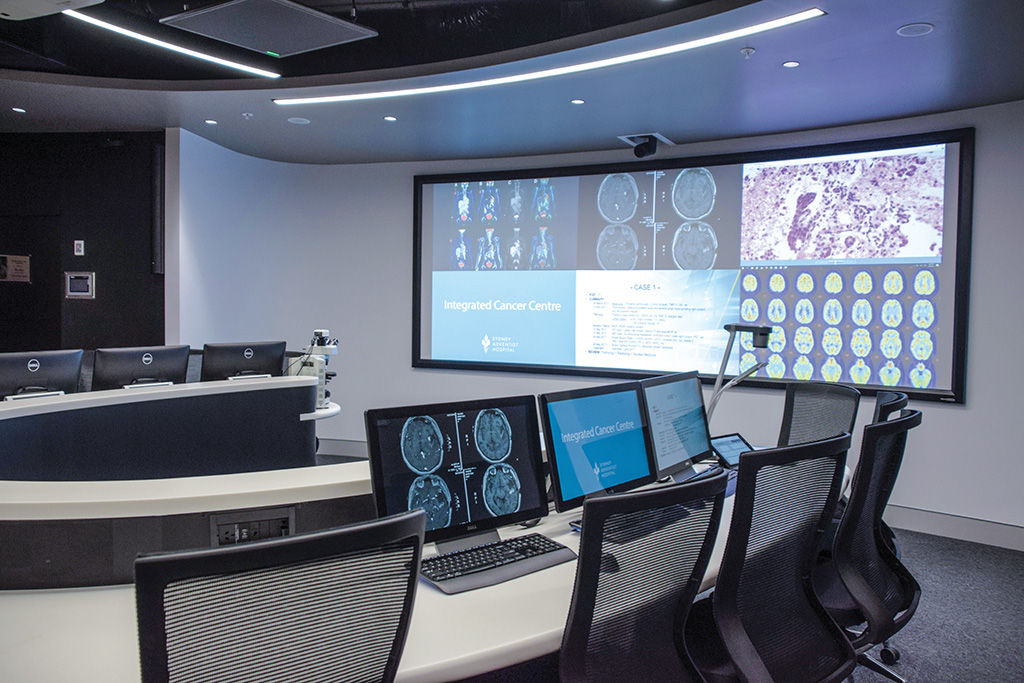
Right Diagnosis
The San Integrated Cancer Centre’s state of the art ‘war room’ has been completed as part of the Sydney Adventist Hospital redevelopment.
Text:/ Christopher Holder
It’s a little like a cross between an episode of House and a meeting of the Jedi High Council. They’re called multi-disciplinary team (MDT) meetings. It’s where the Sydney Adventist Hospital’s Integrated Cancer Centre’s clinicians meet and discuss cases.
Each meeting will be focussed on a certain cancer or tumour stream and will normally last an hour.
Often the MDT meeting will work through some 20 cases in that time. It’s a punishing schedule where lives are at stake.
CRISIS TALKS
Formerly, the MDT meetings were held in boardroom-style rooms with a couple of screens at the front. There was a lot of messing around passing computer keyboards around, or trying (often vainly) to connect a device. If someone was late to the meeting, it’d disturb proceedings… everyone knew it was a less than satisfactory situation but no one had the time or the opportunity to think of a better way.
That was until the new Integrated Cancer Centre was being planned.
Barbara Mackenzie is head of IT operations (officially her title is: Manager, Information Services Operations and Infrastructure Group at Adventist HealthCare) and had a sense that these MDT meetings were special and needed special design attention.
Roneel Singh is an AV/IT consultant with WSP (officially his title is: Technical Director — Head of Technology Systems (ANZ) at WSP) and was engaged to consider this knotty problem, after all, what we’re talking about isn’t a boardroom, or a video conference room or a teaching space, even if there are elements of all three. Barbara describes the break through: “I think the lightbulb moment came when Roneel said: ‘you’re describing a crisis management centre’. That then opened up the thinking, and gave the architect a fresh sense of what the space should be.”
With the big initial breakthrough made, the hard work lay ahead: Barbara, Roneel and his team embarked on a long consultation process to intimately understand the running of an MDT meeting. As Barbara puts it: “What’s different about what we’ve done is to look at the process the clinicians go through and work out how we can better provide technology to support it. Our MDT room is a culmination of everything we’ve learnt.”
AV ANATOMY LESSON
There were some key learnings that provided a framework for the MDT room’s AV:
- Although there may be no more than a dozen or so doctors and specialists contributing to most MDT meetings, the space needed to cater to up to 40 people — mostly observers, such as students, but also additional contributors in the instance of complex cases.
- The space needed to be entirely ‘democratic’ — everyone around the table must feel like an equal voice.
- The MDT room needed to function as a VC space.
- Multiple sources of content needed to be displayed simultaneously (and in a variety of configurations) on the big screen.
- All the audio and video needed to be on the network.
Barbara Mackenzie: “My view has always been: if it’s not IP-based — if it’s not delivered across Ethernet — then it doesn’t belong. That’s a pretty challenging approach to take, especially a few years ago when we were designing the system.”
Roneel Singh: “Barbara’s always maintained she wanted an ‘enterprise solution’. She wanted to standardise and she doesn’t have an AV team or an IT team, she has one team that runs the whole facility.”
Set the challenge, Roneel immediately looked at an SVSI by AMX video-over-IP system.
Barbara Mackenzie: “I absolutely love the SVSI solution.
“This is the first instance where we’ve used a product like this that’s distributed across a network. For example, our Simulation Learning Centre uses a card and frame-based solution, and it is so inflexible. Being able to have a virtualised product instead of hardware-based appliances fits in so well with our approach to technology. And SVSI is a mature solution.”
Roneel Singh: “The solution had to sit on Barbara’s network and take full HD video with very low latency. SVSI had a product that was tested, proven and we’d used it on a number of other jobs in a similar application, so we were confident in recommending it to the client.
“It also meant were were able to do without a large frame-based solution and put the SVSI system into a compact comms room.
“What’s more, the expansion of the system is relatively easy — in effect, Barbara doesn’t need us back for that.”
INTEGRATOR’S VIEW
PLACE FOR HDBASE-T
Jeremy Lewis, Fredon: The future is networking video and audio without the central controller. But there still should be a place for hardware switches — if the price is right. The price needs to come down to a level that makes it a natural fit for smaller, contained system where there’s a known number sources and destinations.
NETWORKED AUDIO
A networked, and scaleable video-over-IP solution needs an audio solution to match. There are plenty of Dante-based audio conferencing solutions on the market but Barbara and Roneel’s consultations suggested on-table gooseneck microphones (or similar) wouldn’t cut it.
Barbara Mackenzie: “I didn’t want a ‘mics on tables’ solution because I wanted it to feel more conversational. In my view, desktop mics foster a ‘one person on the mic at a time’ style of formality that wasn’t appropriate. When the Shure Microphone MXA ceiling array popped up we were really keen to know more.”
Roneel Singh: “We’d normally advise against ceiling mics given the room has an open ceiling and the mics share the ceiling space with the noise of large projectors — regular pendant ceiling mics would sound quite harsh in a space like this.
“But equally, we knew we needed a broad uniform coverage. Some of the clinicians are very softly spoken — you can’t hear them across the 4m diameter of the horseshoe seating — so sound reinforcement would be essential. A traditional approach of a series of mix minuses would have been quite cumbersome.”
Barbara Mackenzie: “Desk microphones also change behaviour. Some people lean right in close to talk into the mic. Some lean way back and mumble. So it’s really wanting to provide a more natural experience, where the technology is working for you even if you don’t notice it working for you. That’s actually my approach to technology across the entire hospital.”
Roneel Singh: “With the Shure MXA ceiling mic array coupled with the JBL distributed loudspeaker system, participants can contribute in their normal speaking voice and they don’t even think they’re being amplified or recorded.”
MORE AUDIO
The Shure MXA beamforming mic array sits above the horseshoe seating with its lobes programmed to dynamically pick up those seated at the table and reject mechanical and ambient noise. An additional six Shure Microflex pendant ceiling microphones cover the ‘gallery’ section of the room.
Audio from the microphones head back through a BSS Audio by HARMAN BLU-806 (loaded with a BLU-103 DSP expander) that takes care of DSP and acoustic echo cancelling.
On the output side, a JBL by HARMAN loudspeaker system ensures a natural sounding speaking environment. A combination of Control 52 and Control 62P loudspeakers cover the room, powered by JBL and Crown by HARMAN amplifiers.
INTEGRATOR’S VIEW
MULTIVIEW TWEAK
Jeremy Lewis, Fredon: We’d successfully deployed SVSI on a number of occasions. And also used the tvONE CORIOmaster Mini prior to that. But not in conjunction as we did in the MDT room. The reason for using the CORIOmaster Mini was to get the best from the variety of sources. It’s helping with the scaling of the images to a point where they suited the particular mode of the source (a slide, an X-ray, a shared screen etc) they were endeavouring to view, to ensure the source was clear enough for the whole room to appreciate what was on the screen.
INTEGRATOR’S VIEW
FINE TUNING THE SHURE MXA910
Jeremy Lewis, Fredon: We’ve had some experience commissioning the Shure MXA910 but this project had some unique layout challenges. We had to stretch some lobes to cover the corners of the horseshoe table and then the automixed output of the Shure mic array then had to play nicely with the Shure MXA ceiling mics in the gallery section of the room.
POSITIVE PROGNOSIS
With innovation, comes a certain amount of consternation. No matter how much you consult, a new approach will throw up the unforeseen. So it was with a few butterflies in the stomach that Barbara and her team sat in on early MDT meetings, aware they had a limited window of opportunity to gain the trust of the clinicians.
Barbara Mackenzie: “We attended every MDT meeting for a number of months. The first comment I recall regarding how the new room was a game changer came from Professor Michael Hughes. There were 20 cases being brought to this particular hour-long meeting. There’s a room full of highly-scheduled specialists, some already in their scrubs ready to go straight up to theatre after the meeting. Professor Hughes in his comments to me reckoned at least 10 minutes were saved because they were able to move seamlessly from one piece of information to the next.
“We have a coordinator who sits at a touchpanel and toggles between the big-screen multiview configurations — bang, bang, bang through each… all different perspectives coming into play without the waiting. Because each of the contributors have their own computer, they can be set up, ready to go. They’re not waiting their turn or interfering with anybody else who is trying to contribute.”
PUTTING HEADS TOGETHER
Increased efficiency is a big deal when time is of the essence. As Barbara puts it: “the whole process flows and the flow of information has momentum”. But of equal importance — and the reason for so many highly paid, time-poor professionals to be convened in the first place — is the cross fertilisation of ideas and information.
Barbara Mackenzie: “Professor Michael Hughes recounted a pivotal moment for him when a pathologist was asked for his input in a meeting. The response was ‘actually, I want to hear what the radiologist has to say first’.
“It doesn’t sound like much but rather than specialists submitting their conclusions about a patient in isolation, they’re actually waiting to hear what others have to say to better inform their own conclusion. So you’re really starting to see how the process is going beyond the sum of the individuals.
“Ultimately I would put it like this: we’re bringing best practice process and the multi-disciplinary process and combining that with the best technology. That elevates the effectiveness of the entire process and ultimately provides a better outcome for the patient.”
INTEGRATOR’S VIEW
SVSI: IN THE GROOVE
Jeremy Lewis, Fredon: We’re accustomed to working with SVSI and similar systems. We’re quite comfortable spec’ing SVSI and we’ve seen it perform well in large corporate environments. It’s now at a price point where it’s become more logical than a big switching solution in many applications. Especially if you’re providing other options to the client, such as adding an extra encoder and decoder wherever they like — it can handle an addition input signal/source or additional destination quite easily.
INTEGRATOR’S VIEW
MAKING CONVERSATION
Jeremy Lewis, Fredon: The MDT room has a totally natural ‘conversational’ sound. It’s not something most clients will demand or necessarily understand but makes a big difference to a meeting or video conference. These days the video aspects of a video conference generally look great and are dependable. It’s the audio component that more often fails. Justin Rotondo from our team took care of the audio commissioning. He’s spent an entire career perfecting audio and when he walks away that system is as good as it’s every going to get.
GEAR HIGHLIGHTS
- Shure Microflex MXA910B Beamforming Microphone Array
- Shure Microflex MX202BPC Overhead Microphones
- SVSI by AMX Video-over-IP System
- Epson EPL1200UNL Projectors
- tvONE CORIOmaster Mini
- Lumens PS752 Document Camera
- JBL Control Series Loudspeakers
- BSS Audio Soundweb BLU DSP
- Williamsound Hearing Augmentation
- Polycom Group 500 VC Codec
- Panasonic AW-HE130W/K VC Camera
- Barco ClickShare
- Crestron AirMedia
- Screen Technics 1500mm x 4200mm curved screen













RESPONSES